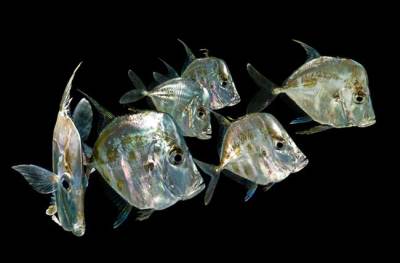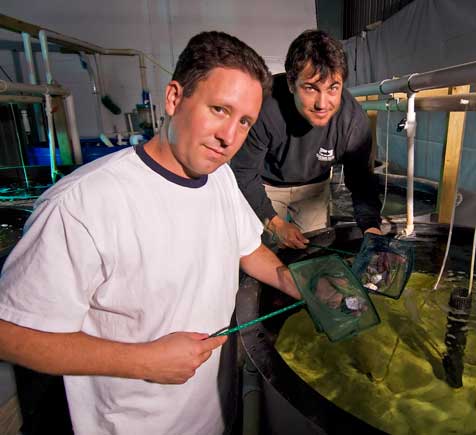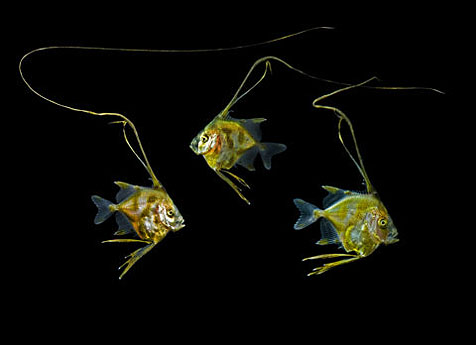
Selene vomer coming in commercial quantities
By Matthew Pedersen with images by Matthew L. Wittenrich
Excerpt from the January/February issue of CORAL
By Matthew Pedersen with images by Matthew L. Wittenrich
The Lookdown, Selene vomer, is one of only a few iconic “big ocean” marine species that are sometimes kept in home aquariums. Unlike the typical “reef fish” appearance with gaudy colors and intricate patterns, Lookdowns present a truly singular vision: a wafer-thin laterally-compressed body with mirror-like and highly reflective tiny silver scales, high-set eyes, low-set mouth, a steep concave forehead, long dorsal and anal fin extensions, wing-like pectoral fins and a deeply forked caudal fin—all hinting at a predator designed for speed and agility.
With such a unique appearance, large shoals of Lookdowns, chromed to the gills, are often selected for public aquarium displays. These are naturally schooling fish, members of the Carangidae (Jacks and Pompanos), typically found over hard or sandy bottoms, and juveniles are typically encountered in estuaries or off sandy beaches. Native to Western Atlantic coastal waters, ranging from Maine all the way south to Uruguay, most Lookdowns enter the marine aquarium trade from collectors in Florida.
Now, Florida-based marine fish hatchery Proaquatix is grabbing our attention by making the first public commercial release of captive-bred Lookdowns for home aquariums. Eric Wagner, manager and head scientist at Proaquatix, says that Proaquatix actually reared captive-spawned Lookdowns years earlier in 2003 as a fun side-project, with the resultant offspring going to public aquariums. While Wagner won’t make this claim, it is worth mentioning that Proaquatix may have been the first individuals / organization to breed this species successfully. (Algagen, another Florida aquaculture facility, has also produced Selene vomer successfully, but not a commercial scale.)

Wagner, above left / Fabricio Bueno, above right
Reserving a few proprietary details, Wagner, above left, is willing to discuss most of the breeding details for the Lookdown, and is also quick to note that Fabricio Bueno, above right, the assistant manager and larval expert at Proaquatix, deserves a tremendous amount of credit for the Lookdowns. Wagner dispels the myth that these fish are captive-raised (juveniles harvested from the ocean and grown out) and not captive-bred.
The breeding process started with adult Lookdowns, collected in the wild and kept in a 1,500 gallon (5,678 L) fiberglass tank. Initially this broodstock was conditioned with lighting schedules to simulate seasonal changes. Then, utilizing a hormone application, the pre-conditioned fish were brought into spawning condition resulting in viable gametes. The first egg collection was estimated at 300,000 eggs, with each pelagic egg being roughly 0.7 to 0.8 mm (0.03 inches) in diameter.
It takes only 24-30 hours for the eggs to hatch and another 48 to 72 hours before larvae begin to feed. Proaquatix is not willing to reveal what first larval feeds are used, but they say that 200 gallon (750 L) rearing vessels are employed. The larvae grow relatively quickly, and metamorphosis starts at three weeks post-hatch. At three weeks of age, the babies are roughly 0.3 inches (0.75 cm) in body length, with 6-inch (15 cm) dorsal trailers. These ridiculously long dorsal extensions cause all sorts of problems with fish tangling and getting stuck in the surface film.
Additionally, swim bladder / gas related issues are an ongoing problem, further compounding the issues of tiny, tangled larvae. While the best solution has yet to be identified, water circulation parameters seem to be influential factors in reducing these problems.
By five weeks of age, most of the larval rearing issues have passed and the babies are pretty resilient. The highest success rate has been 3.3% – roughly 30 juveniles for every 1,000 eggs. Surprisingly, at only 8 weeks post hatch, the baby Lookdowns have grown to a sufficient size for retail sale—they are already “quarter size” (roughly 1 inch, 2.5 cm in total length, excluding fin extensions), a tremendous growth rate for a marine ornamental. Proaquatix says that they experience no particular shipping or care issues with these fish —young Lookdowns simply dislike poor water quality or temperature changes like any other marine fish.
 Aquarium Husbandry
Aquarium Husbandry
Captive care of Lookdowns is relatively easy, and they make for eyecatching display animals in a larger home aquarium. These are large fish, growing to over 12” (30 cm) in length with some reports putting this species at 18” (45 cm). They are undeniably cute as babies, but you must be prepared to house them for the long term – most retailers recommend aquariums over 150 gallons in size for young Lookdowns. The system must have end-to-end open space for them to exercise their athletic swimming abilities.These roving predators are quick to make a meal of anything meaty that fits in their mouth. New specimens will greedily accept Mysis, enriched brine shrimp, small krill and other carnivore rations. They are natural shoalers and best kept in groups—five or more make a spectacular sight. In private aquariums they often are used to add another dimension to “predator” tanks containing large, rugged tankmates such as Groupers and Lionfish.
Even with captive breeding offering a new supply, Lookdowns remain uncommon in the marine aquarium trade and seem to be snapped up pretty quickly whenever they appear. Captive-bred Lookdowns offer advantages over their wild caught counterparts, being far less prone to bacterial issues that can often cause losses in wild fish. Additionally, captive-bred Lookdowns can be purchased at far smaller sizes and slightly lower prices than most wild-caught specimens.
2011 promises more Lookdowns from Proaquatix, which is also focusing on other consistent sellers to help ensure a solid financial footing for the company in the years to come. This means we should see the return of some unique species that Proaquatix became known for breeding in the early 2000’s, hopefully including species such as Flametail Blennies (Enchelyurus flavipes) and Fang Blennies (Mieacanthus species), various gobies including some Shrimp Gobies (Cryptocentrus cinctus, C. leptocephalus, C. lutheri), as well as staple Dottyback and Clownfish species. Still, Eric Wagner hints there could be a wildcard or two in 2011 and 2012 to keep us on our toes – we’ll all be watching. [Coral Magazine]
Matthew Pedersen is a marine fish breeder and recipient of the 2009 MACNA Aquarist of the Year Award. He lives in Duluth, Minnesota.
Matthew L. Wittenrich is the author of The Complete Illustrated Breeder’s Guide to Marine Aquarium Fishes and recipient of the 2010 MACNA Aquarist of the Year Award. He lives in Melbourne, Florida.
References
Proaquatix Online – www.Proaquatix.com
Videos of Captive-bred Lookdowns @ ReefBuilders – http://reefbuilders.com/2010/06/19/lookdown-fish-selene-vomer-captive-ra…
Fishbase Reference for Selene vomer – http://www.fishbase.org/summary/speciessummary.php?id=1004
